Chlorophytum comosum
Chlorophytum comosum, often called spider plant but also known as airplane plant, St. Bernard's lily, spider ivy, ribbon plant,[2] and hen and chickens[3] is a species of perennial flowering plant. It is native to tropical and southern Africa, but has become naturalized in other parts of the world, including western Australia.[4][5] Chlorophytum comosum is easy to grow as a houseplant; variegated forms are the most popular.
| Chlorophytum comosum | |
|---|---|
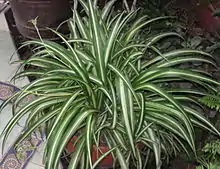 | |
| Chlorophytum comosum 'Vittatum' | |
| Scientific classification | |
| Kingdom: | Plantae |
| Clade: | Tracheophytes |
| Clade: | Angiosperms |
| Clade: | Monocots |
| Order: | Asparagales |
| Family: | Asparagaceae |
| Subfamily: | Agavoideae |
| Genus: | Chlorophytum |
| Species: | C. comosum |
| Binomial name | |
| Chlorophytum comosum | |
| Synonyms | |
| |
Description
Chlorophytum comosum grows to about 60 cm (24 in) tall. It has fleshy, tuberous roots, each about 5–10 cm (2–4 in) long. The long narrow leaves reach a length of 20–45 cm (8–18 in) and are around 6–25 millimetres (0.2–1.0 in) wide.[6]
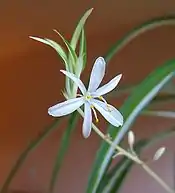
Flowers are produced in a long, branched inflorescence, which can reach a length of up to 75 cm (30 in) and eventually bends downwards to meet the earth. Flowers initially occur in clusters of 1–6 at intervals along the stem (scape) of the inflorescence. Each cluster is at the base of a bract, which ranges from 2–8 cm (0.8–3.1 in) in length, becoming smaller towards the end of the inflorescence. Most of the flowers which are produced initially die off, so that the inflorescences are relatively sparsely flowered.[6]
Individual flowers are greenish-white, borne on stalks (pedicels) some 4–8 mm (0.2–0.3 in) long. Each flower has six triply veined tepals which are 6–9 mm (0.2–0.4 in) long and slightly hooded or boat-shaped at their tips. The stamens consist of a pollen-producing anther about 3.5 mm (0.1 in) long with a filament of similar length or slightly longer. The central style is 3–8 mm (0.1–0.3 in) long. Seeds are produced in a capsule, 3–8 mm (0.1–0.3 in) long, on stalks (pedicels) which lengthen to up to 12 mm (0.5 in).[6]
The inflorescences carry plantlets at the tips of their branches, which eventually droop and touch the soil, developing adventitious roots. The stems (scapes) of the inflorescence are called "stolons" in some sources, but this term is more correctly used for stems which do not bear flowers and have roots at the nodes.[7]
Taxonomy
Chlorophytum comosum was first formally described by the Swedish naturalist Carl Peter Thunberg as Anthericum comosum in the 1794 volume of Prodromus Plantarum Capensium, Thunberg's work on the plants of South Africa.[8][9] It was subsequently moved to a number of different genera, including Phalangium, Caesia, Hartwegia Nees and Hollia, before receiving its current placement in Chlorophytum by Jacques in 1862.[4]
The species has been confused with Chlorophytum capense (L.) Voss by some authors, but this is a different species.[1]
Intra-specific variation
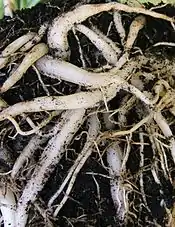
There are three described varieties of the species: the autonym C. comosum var. comosum has strap-shaped narrow leaves and is found along forest margins, C. comosum var. bipindense has broader, petiolate leaves with stripes on the underside and the inflorescences are 2–3 times the length of the leaves, and C. comosum var. sparsiflorum also has broader leaves that narrow to the base and usually lacks a petiole and the striping on the underside of the leaf and the inflorescences are up to two times the length of the leaves. The latter two are rain forest-dwelling taxa that had earlier been described as separate species, but botanists Axel Dalberg Poulsen and Inger Nordal reduced the taxa to varieties of C. comosum in 2005.[10]
Delimitation of species boundaries within the genus Chlorophytum is reported to be difficult, possibly because of several evolutionary radiations into forest environments that led to morphological aspects that are too similar to reliably distinguish separate species. The evidence given to support this is the widespread distribution of most taxa in the genus and poor seed dispersal, leading to the conclusion of deeper evolutionary divergence among the taxa.
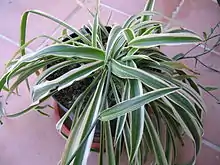
The three described varieties in C. comosum could be an example of this convergent evolution of leaf shape among the forest-dwelling varieties from species of disparate origin, leading to the species C. comosum being polyphyletic, instead of the traditional view of morphological divergence among the varieties within the species with the assumption of a common origin (monophyly). The widespread C. comosum var. comosum has slender, near linear leaves that lack a petiole similar to plants found in cultivation and is only found growing at the margins of the rain forest. The two other varieties, C. comosum var. sparsiflorum and C. comosum var. bipindense, possess petioles and have broader leaves necessary for collecting more light in the shady Guineo-Congolean rain forest. A study published in 2005 used 16 morphological characters and was unable to delimit species boundaries among these three taxa, so they were relegated to varietal status.[10] A follow-up study published in 2008 provided preliminary evidence from phylogenetic analysis of plastid and nuclear DNA sequences that established samples from disparate collections sites identified as C. comosum were polyphyletic.[11]
Distribution
Chlorophytum comosum has a widespread native distribution in Africa, being native to six of the 10 World Geographical Scheme for Recording Plant Distributions regions of Africa (West Tropical Africa, West-Central Tropical Africa, Northeast Tropical Africa, East Tropical Africa, South Tropical Africa and Southern Africa).[4]
Cultivation
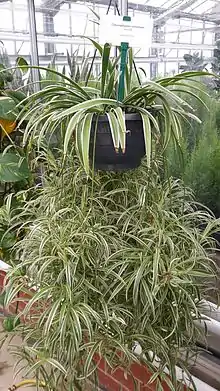
Chlorophytum comosum is a popular houseplant. The species with all-green leaves forms only a small proportion of plants sold. More common are two variegated cultivars:[2]
- C. comosum 'Vittatum' has mid-green leaves with a broad central white stripe. It is often sold in hanging baskets to display the plantlets.[2] The long stems are white.
- C. comosum 'Variegatum' has darker green leaves with white margins. It is generally smaller than the previous cultivar.[2] The long stems are green.
Both cultivars have gained the Royal Horticultural Society's Award of Garden Merit[12][13] (confirmed 2017).[14]
Propagation
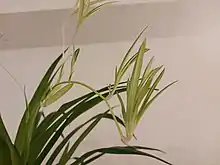
Propagating Chlorophytum comosum commonly occurs through potting the plantlets, informally referred to as 'spiderettes',[15] or 'pups',[16] directly into potting soil attached to the main plant or cutting the running stems and then potting it.
Spider plants are easy to grow, being able to thrive in a wide range of conditions. They will tolerate temperatures down to 2 °C (35 °F), but grow best at temperatures between 18 °C (65 °F) and 32 °C (90 °F). Plants can be damaged by high fluoride or boron levels.[2]
Air purification
The NASA Clean Air Study determined that this plant was effective at removing common household air toxins formaldehyde and xylene.
Spider plants have also been shown to reduce indoor air pollution in the form of formaldehyde, and approximately 70 plants would neutralize the formaldehyde released by materials in a representative (ca. 167 m2 [1,800 sq ft]) energy-efficient house, assuming each plant occupies a 3.8 L (0.84 imp gal; 1.0 US gal) pot.[17]
See also
References
- "Chlorophytum comosum". Germplasm Resources Information Network (GRIN). Agricultural Research Service (ARS), United States Department of Agriculture (USDA). Retrieved 2008-03-17.
- Poole, R.T.; Chase, A.R. & Osborne, L.S. (1991), Spider Plant Production Guide (CFREC-Apopka Foliage Plant Research Note RH-91-33), Central Florida Research and Education Center, University of Florida, retrieved 2011-09-26
- Ernst van Jaarsveld (November 2012). "Chlorophytum comosum". PlantZAfrica.com. South African National Biodiversity Institute. Retrieved June 27, 2016.
- World Checklist of Selected Plant Families, The Board of Trustees of the Royal Botanic Gardens, Kew, retrieved 2011-09-26, search for "Chlorophytum comosum"
- Howell, J.T., P.H. Raven & P. Rubtzoff. 1958. Flora of San Francisco. Wasmann J. Biology 16:1-155.
- McCune, S. & Hardin, D. W. (1994), "Chlorophytum comosum (Thunb.) Jacques", PlantNET - The Plant Information Network System of The Royal Botanic Gardens and Domain Trust, Sydney, Australia: The Royal Botanic Gardens and Domain Trust, retrieved 2011-09-27
- Hickey, M.; King, C. (2001). The Cambridge Illustrated Glossary of Botanical Terms. Cambridge University Press.
- "Anthericum comosum Thunb., Prodr. Pl. Cap. 1: 63 (1794)". International Plant Names Index (IPNI). Royal Botanic Gardens, Kew. Retrieved 26 September 2011.
- Thunberg, Carl Peter. 1794. Prodromus Plantarum Capensium. p. 63.
- Poulsen, AD, and I Nordal. 2005. A phenetic analysis and revision of Guineo-Congolean rain forest taxa of Chlorophytum (Anthericaceae). Botanical Journal of the Linnean Society, 148: 1-20.
- Bjorå, CS, A Hemp, G Hoell, and I Nordal. 2008. A taxonomic and ecological analysis of two forest Chlorophytum taxa (Anthericaceae) on Mount Kilimanjaro, Tanzania. Plant Systematics and Evolution, 274: 243-253.
- "Chlorophytum comosum 'Variegatum' (v) | variegated spider ivy/RHS Gardening".
- "Chlorophytum comosum 'Vittatum' (v) | spider ivy 'Vittatum'/RHS Gardening".
- "AGM Plants - Ornamental" (PDF). Royal Horticultural Society. July 2017. p. 18. Retrieved 24 January 2018.
- "StackPath". www.gardeningknowhow.com. Retrieved 2020-11-13.
- Almanac, Old Farmer's. "Spider Plants". Old Farmer's Almanac. Retrieved 2020-11-13.
- Wolverton, B. C.; McDonald, Rebecca C.; Watkins, E. A. (1984). "Foliage plants for removing indoor air pollutants from energy-efficient homes" (PDF). Economic Botany. 38 (2): 224–228. doi:10.1007/BF02858837. hdl:2060/19860066312. S2CID 41933312. Archived from the original (PDF) on April 27, 2015.
External links
 Media related to Chlorophytum comosum at Wikimedia Commons
Media related to Chlorophytum comosum at Wikimedia Commons